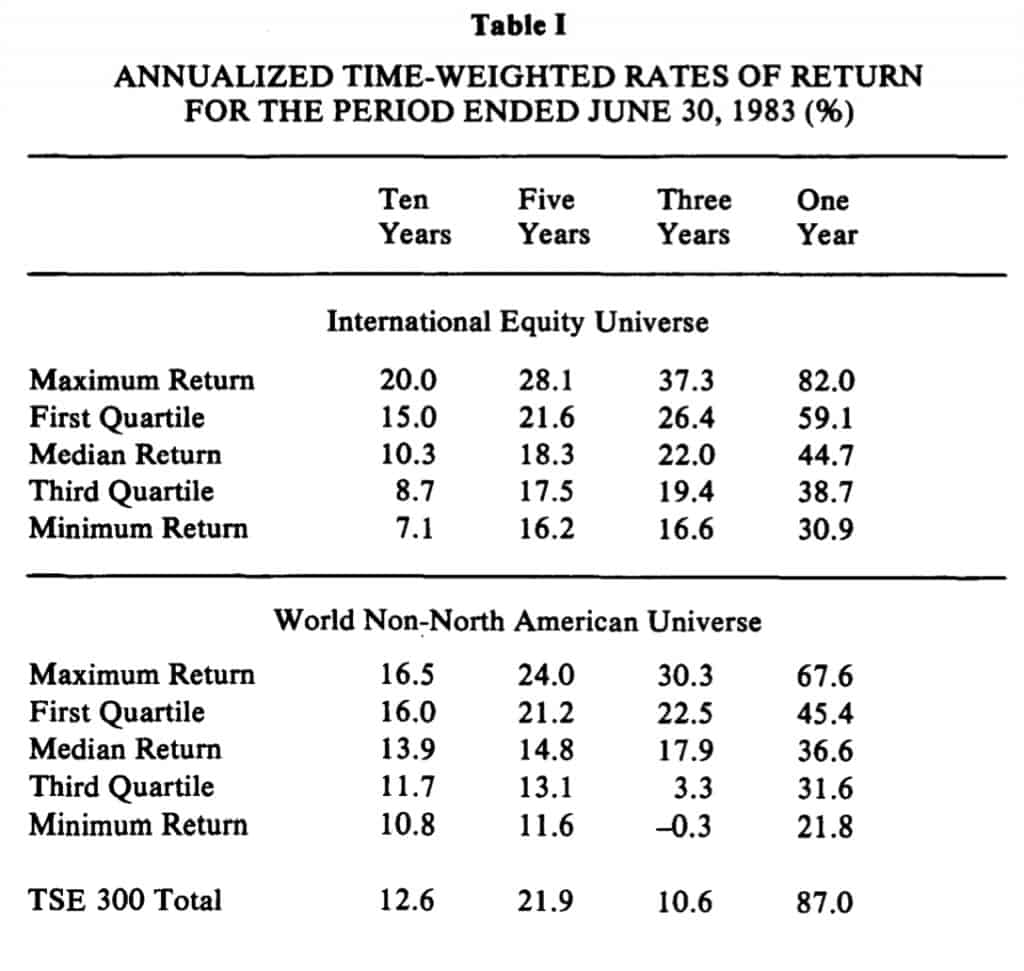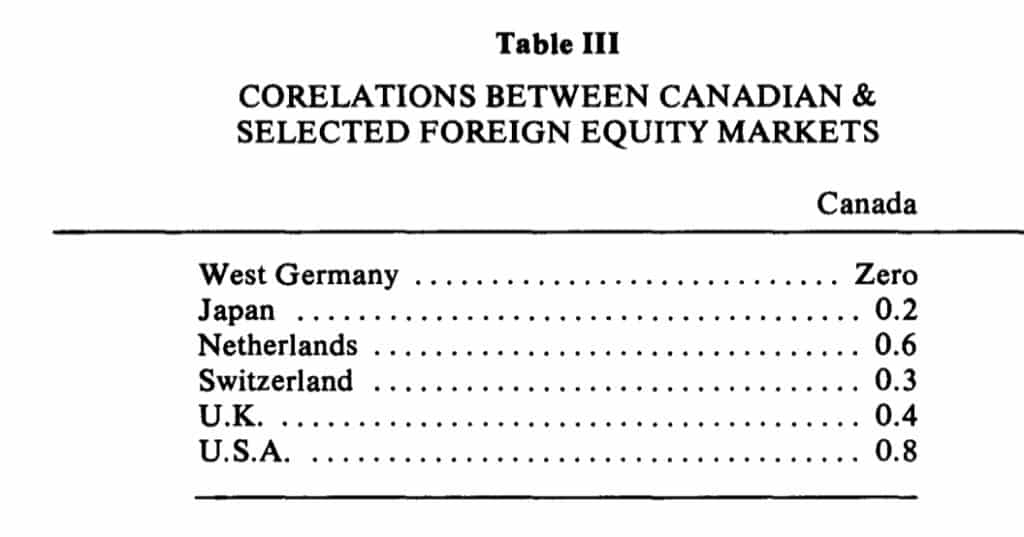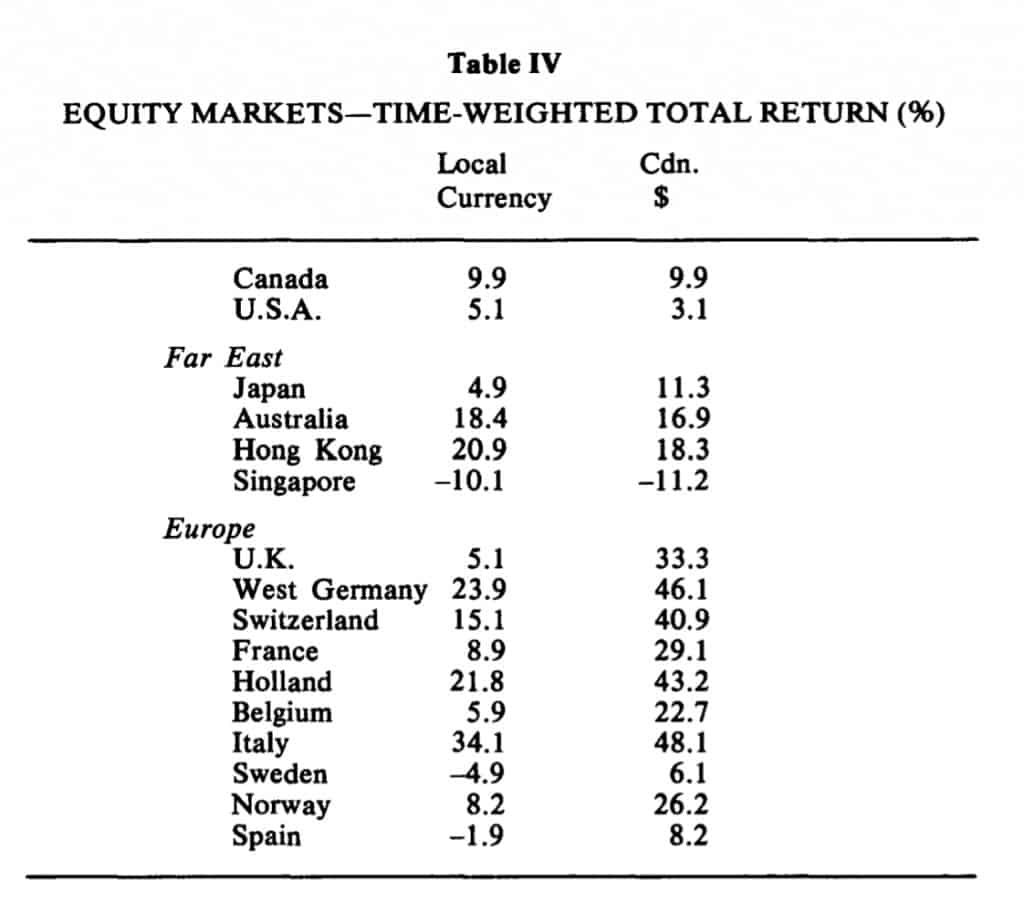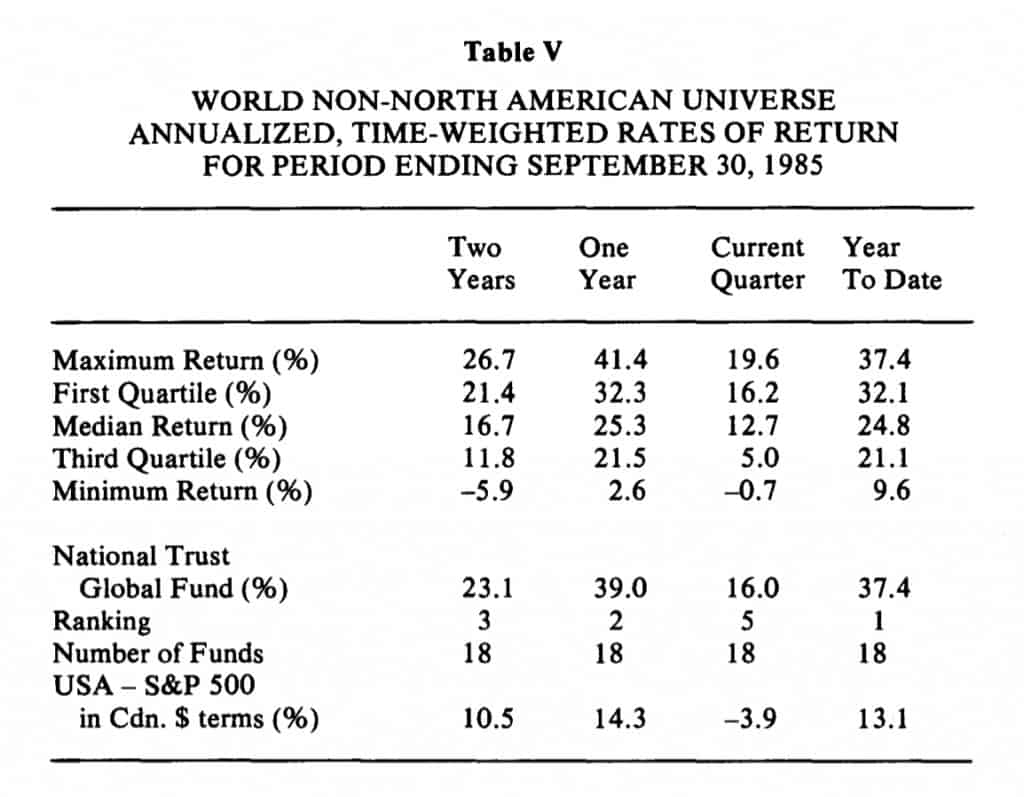Introduction
The subject of foreign investments is not new to us in Canada-we have been interested in having foreigners invest in our country for many years now. However, the subject ofthis paper is Canadian investment in overseas markets and I would like to cover three particular areas:
• the benefits of international investment;
• international management and research; and
• international investment performance.
Canadian institutional investment outside Canada has been slow to start. However, in recent years, more and more Canadian institutions have begun to invest in the United States of America, presumably because the market is close by, and because events there may be followed on a daily basis. Indeed, when reviewing the recent performance of the United States and Canadian stock market indices, the two markets may be considered almost as one.
To illustrate the low level of Canadian investment outside Canada, recent statistics for trusteed Canadian pension plans indicate that, of $100 billion of assets, only some five per cent is invested outside Canada, and that 99 per cent of that five per cent is invested in the United States.
However, in the United States itself, investment in non-North American markets is beginning to increase rapidly and it is projected that, over the next 10 years, while pension assets in North America will grow by a factor ofXS, the international commitment of those assets will grow by a factor ofX10, or twice as fast. Since the trend in Canada is to follow trends in the United States, it seems probable that Canadian investment overseas will increase rapidly in the coming years.
International Investment Benefits
We believe that the movement towards the non-North American markets is gathering momentum because of the benefits which accrue to investors in those markets. These include:
• broader scope of world markets
• improved potential return
• reduced risk exposure
• reduced market covariance
• currency diversification
• participation in growth areas
• increased international awareness.
Broader Scope of World Markets
Utilizing only Canadian and United States markets limits the scope of investment to only about half the world’s potential marketplaces. Most major countries where stock exchange investment is possible have broad areas or industries of specialization. In Japan, for example, comparative strengths include the electronics, automobile and steel industries, with a distinct weakness in the energy and raw material sectors. In Australia, by contrast, manufacturing industry tends to be less competitive and less important but investment opportunities are usually available in the agricultural, mineral and energy fields. At different stages of world economic activity the balance of investment advantage will vary between Japan and Australia. Similar considerations apply within Europe with, for example, West Germany showing strength in engineering, chemicals and automobiles, the United Kingdom showing strength in finance and oil and Switzerland showing strength in drugs, banking and food. At different times these comparative advantages will add their respective strengths to an international portfolio.
Improved Potential Return
These performance results are reproduced by courtesy of Hitchens Capital Management in Vancouver, and they reflect two universes of Canadian pension plan investment funds. The “international” universe consists of some38 plans which invest in the United States. The “world non-North American” universe consists of18 plans which invest outside of North America.
Reviewing the results, it becomes evident that for the international universe (i.e., United States investments) the median return is 10.3 per cent over10 years, and the world non-North American universe (i.e., off-shore North America) the median is 13.9 per cent or 35 per cent better.
Work done by the Sobeco Group Inc. seems to indicate the same trend:
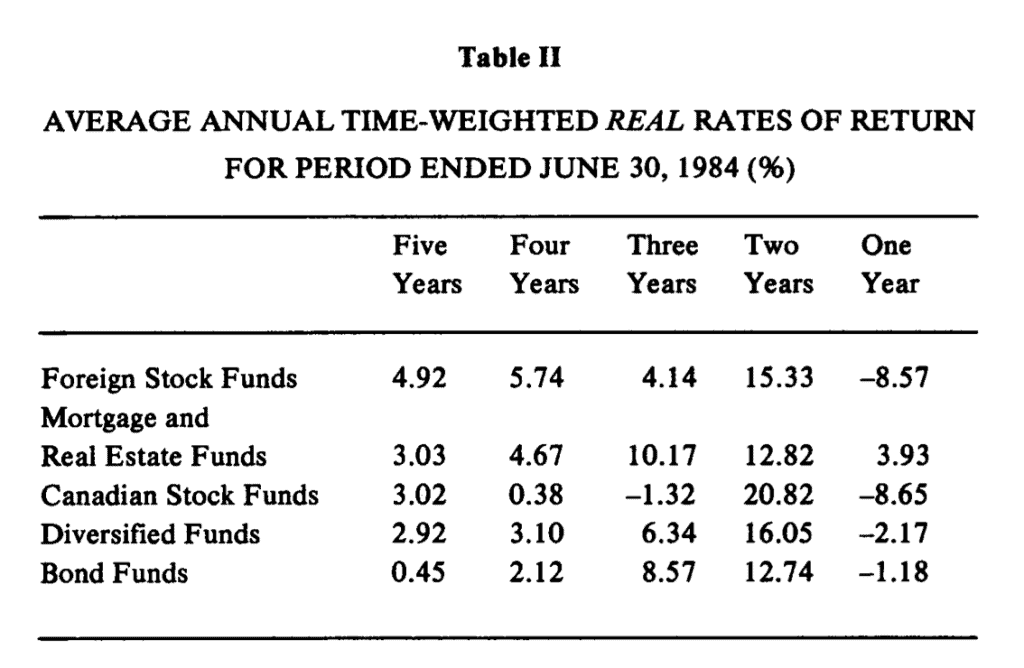
Again, reviewing the long-term, five-year numbers, foreign stock funds in the Sobeco universe clearly outperformed the remaining asset categories.
Reduced Risk Exposure
It is an established investment principle that in order to reduce the volatility and variability of investment returns, investment should be diversified. The normal example is an equity portfolio of at least15 to20 companies. In this way the portfolio is not unduly exposed in the event that one or two companies run into difficulties and provide a poor share price performance. It is, of course, equally true that a small number of successful companies will have a diluted effect within a diversified portfolio, but where risk reduction is an important principle—and this is usual in the case of a pension fund-this is an acceptable result of diversification. The same argument holds true for investment in a range of investment markets as for a range of shares. By diversification across markets the sharp ups and downs of individual markets are smoothed. Reduced volatility equals reduced risk.
It will be noticed that in the Hitchens universe shown in Table I, the variability of returns between the best and worst performance is much narrower for the nonNorth American funds than the United States funds (5.7 versus 12.9 over 10 years).
Reduced Covariance
Most Canadian fund managers feel that diversification into the United States market is sufficient. However, the Canadian and United States markets have a nearly perfect corelationship, or covariance, factor. On the other hand, European and Pacific Rim countries have a very low, and in some cases, a zero, or negative, Canadian covariance factor. It is this low covariance factor which gives rise to the benefits of improved potential return and reduced risk exposure outlined in the preceding paragraphs.
Currency Diversification
Many areas of the world offer superior growth potential compared to Canada and the United States. When those superior returns are adjusted to Canadian dollars, the results are astonishing. For example, the equity market in Singapore grew 53 percent over the 10 years ended 1983 but in Canadian dollar terms, the growth was 154 per cent. The Japanese market’s growth of 82 per cent over the same period more than doubled to 188 per cent in Canadian dollar terms. On the other hand, Canadian investors in the United States equity and bond markets were saved from a net loss position only by the favourable currency conversion factor.
More recent numbers for the currency effect are, for the six months ended August 30, 1985:
The currency advantage will fluctuate with the economic cycle, depending upon a country’s strengths and weaknesses. Thus, the yen, Deutschemark and Swiss franc have tended to perform well in a low-interest-rate environment, and sterling, for example, has a comparative advantage when there is upward pressure on oil prices.
Growth Areas and Unusual Opportunitities
The Canadian and United States economies are now relatively mature and will show only a modest increase in growth in the years ahead. On the other hand, Australia, Singapore, Hong Kong, and Korea are only just beginning an era of explosive growth, while Japan and some European economies continue to grow much faster than the North American economies in general. The potential for China as an area of investment is virtually limitless. This situation presents many opportunities for investment in growth economies, sectors, and industries, as well as unusual opportunities, as new industries and entrepreneurs spring up world-wide.
International Awareness
International diversification of a portfolio brings with it an increased international awareness, because of exposure to the necessary research into foreignpolitics, economies and markets. This increased flow of international information makes investors perhaps more aware than they otherwise would be of the effect of these foreign activities upon their portfolios of Canadian securities.
Considerations
Taxes
Taxes and other government levies may have an important affect on foreign investment. The exact effect for each investor must be studied and compared with the anticipated rate of return from the investment.
Foreign Investment Risks
An overseas investment program necessarily will assume political, economic and stock market risks within the countries selected, and these risks are, of course, supplementary to the normal domestic investment risks. It should be recognized, however, that similar risks are assumed to a greater or lesser extent by domestic investment and ultimately it may be in the beneficiaries’ best interest to have some dilution of such domestic risks which may be beyond the control of the domestic government and most certainly the domestic investment manager.
Conclusion
Most active international investment programs are carried out when the domestic investment outlook appears unsatisfactory. It is then hoped that overseas investment will provide an incremental return to the portfolio. Questions of this nature are necessarily difficult to quantify because future investment returns are never certain. In normal circumstances, however, equity and fixed-income investment in non-North American markets should provide an attractive investment return for the beneficiaries of a Canadian institutional investment program.
International Investment Management and Research
If the benefits of international investment are found to be attractive, then the next question is: how do we go about it? How do we participate in these markets which, to many of us, seem so remote?
We at National Trust believe that the solution lies in finding an investment manager who is well-versed in these markets and who has the expertise and experience to lead us gently into this new area of investment. We found such a manager in Hill Samuel Asset Management International which is part of the Hill Samuel Group Pic, a large London-based, financial services company whose stock is publicly traded in London, England. The attributes which we found in Hill Samuel are those which anyone planning international investment should seek—a highly centralized decision-making process; extensive contacts around the world yet operating in London, England the centre of world finance; more than 50 investment managers who act as research analysts; more than C$15 billion (equivalent) under management; and a prestigious clientele, which in Hill Samuel’s case includes such names as the British Broadcasting Corporation, British Rail, Ford, Trusthouse Forte, and MacMillan Bloedel.
A complete analysis of Hill Samuel’s research capabilities and management style is impossible in a short paper. In general, National Trust Company and Hill Samuel Asset Management International believe that international investment is a logical and prudent extension of Canadian investment and that it is consistent with the fundamental goals of Canadian institutional investors, i.e., to identify and invest in undervalued securities without exposure to unacceptable levels of risk. The key components of our investment philosophy are emphasis on client objectives, fundamental value, integrated analysis and portfolio construction.
However, this paper will attempt to give some idea of the research which an investment house like Hill Samuel must carry out as a basis for its international investment activity. Equity and bond markets and currency exchange rates as well as political and economic developments around the world must be kept under constant review. At Hill Samuel, the distillation of all the work done is published in-house in the form of equity, fixed-income, and currency schedules.
In essence, these schedules give measures of both the long-term relative cheapness and the short-term ( 12 months) expectations for markets, currencies, industry groups, and individual stocks. Thus, it is possible to establish currency-adjusted, relative values, for both the short term and the longer term. This in turn allows direct comparison of risk and reward between, say, a bond in Germany and a stock in Japan, and portfolios can be assembled accordingly, with due consideration of client investment objectives and risk constraints.
Investment Performance The National Trust Global Fund was launched in March, 1983, and now has $85 million under investment management across most of the world markets, except Canada and the United States. The Fund’s first 12-month total return was 25.7 per cent which may be compared to the Toronto Stock Exchange Index of 300 Stocks’ return of 14.7 per cent, and the Standard and Poor Index of500 Stocks’ return of 12.1 per cent (adjusted to Canadian dollar terms). In addition, the Fund’s return was achieved without the volatility suffered by these indices—a result that is in line with international investment theory. Subsequent fund performance (courtesy of Hitchens Capital Management) is shown in Table V.
Conclusion
The international diversification theory was advanced by academic economists many years ago. Today, many investment managers around the world are reaping the practical benefits of the theory for their clients. Experience shows that investment in markets around the world maximizes rewards and minimizes risk-surely the ideal investment situation.
MICHAEL S.F. HOW
National Manager, Marketing, National Trust
